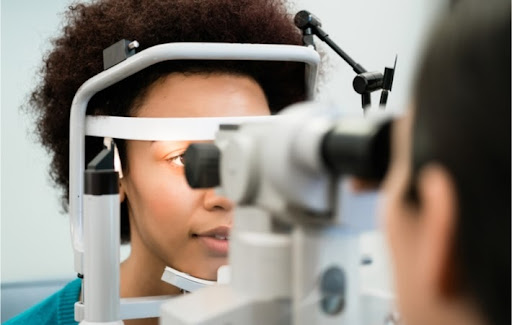If you’re suffering from headaches, sore neck, or tired eyes after using the computer or reading, what’s causing this discomfort? A common concern is digital eye strain, but there may be another factor at play.
If you’re experiencing irritating headaches, your optometrist may recommend Neurolens as a treatment option, but what is this? Learn more about Neurolens, including what it is, how it works, and how to know if it’s right for you.
What is Neurolens?
Neurolens is specialized eyewear featuring prescription lenses with a contoured prism to help relieve headaches, neck and shoulder pain, and eye fatigue. Over 65% of Americans experience headaches, pain, and fatigue when completing close-up work like reading.
These symptoms are typically associated with a condition known as digital eye strain.
What is Digital Eye Strain?
Digital eye strain, or computer vision syndrome, is a common condition where your eyes feel dry, strained, and uncomfortable after using digital devices for long periods. This overuse can lead to several irritating symptoms, including:
- Eye fatigue
- Headaches
- Blurred vision
- Dry eyes
- Neck & shoulder pain
These symptoms can develop for many reasons but typically occur due to how you use your devices. People tend to have poor posture, look at devices from ineffective distances, and not blink enough.
Treatment for digital eye strain focuses on prevention through the changing of your habits. These changes can include how you view your computer, how often you take breaks, and adjusting your work environment.
However, there is an often overlooked aspect for why you have headaches and feel sore after using the computer or reading, your eyes may be misaligned. These misalignments need treatment to reduce your symptoms, and Neurolens can help.
What is a Misalignment of the Eyes?
A misalignment of your eyes, such as convergence insufficiency, is a condition where your eyes cannot effectively work together when looking at an object. While not everyone will have symptoms of this condition, common signs of convergence insufficiency include:
- Tired, sore, or uncomfortable eyes
- Headaches
- Difficulty reading
- Double vision
- Difficulty concentrating
- Squinting, rubbing, or closing one eye
Your visual system is more strained when your eyes aren’t working together, leading to some of these symptoms. What is the cause of this misalignment?
What Causes Convergence Insufficiency?
There’s no specific cause known for this condition, only that it involves a misalignment with your eyes when focusing on nearby objects. This misalignment happens due to the muscles moving your eyes, causing one to drift outward when focusing on a nearby word or image.
Headaches, pain, and other symptoms linked to digital eye strain can happen when your trigeminal nerve is overstimulated because of this condition.
The overstimulation of this nerve is known as trigeminal dysphoria. This condition can result in headaches, strained eyes, and neck stiffness.
Because Neurolens addresses misaligned eyes, how does this treatment work?

How Does Neurolens Work?
For 90% of patients, their eye misalignment is worse when completing near work (like working on a computer). Neurolens can help reduce the uncomfortable symptoms caused by eye misalignment, but how does this treatment work?
Neurolens features contoured prism lenses that help bring your eyes into proper alignment. If you don’t require a prescription for vision correction, these lenses can still help reduce the stress placed on your trigeminal nerve.
After your optometrist completes an evaluation of your eyes, they can determine the type of lenses you need. Afterward, you’ll receive your Neurolens prescription to help relieve your symptoms.
This treatment is effective, with 93% of patients reporting a reduction in their overall symptoms and 73% saying their symptoms were virtually gone after 90 days.
How Do You Know Neurolens Are for You?
If you’re experiencing symptoms of trigeminal dysphoria, Neurolens may be an effective treatment for you. Common symptoms include:
- Tired eyes
- Neck pain or stiffness
- Light sensitivity
- Discomfort when working on the computer
- Dry eyes
- Headaches
- Dizziness
After completing a measurement test of your eyes, your optometrist can prescribe Neurolens to help with your discomfort. These symptoms are similar to digital eye strain, but how can you tell if your eyes are misaligned or if it’s another condition?
Are You Experiencing Digital Eye Strain or Misalignment of Your Eyes?
How can you tell the difference between digital eye strain and the misalignment of your eyes? These conditions have similar symptoms, and you may not notice what’s specifically affecting you. The best way to catch any problems is to visit your optometrist for a comprehensive eye exam.
Your optometrist can help determine the cause of your irritation and recommend an effective treatment for your needs. You don’t need to deal with headaches; your eye doctor can help you find relief. If you’re experiencing headaches when completing close-up work or are interested in Neurolens, book an appointment today.



